A Novel Broadband Monopole Antenna with T-Slot, CB-CPW, Parasitic Stripe and Heart-Shaped Slice for 5G Applications
Abstract
1. Introduction
2. Analysis and Design of the Antenna
2.1. Antenna Analysis
2.2. Antenna Design
3. Simulation and Measurement
4. Discussion
5. Conclusions
Author Contributions
Funding
Acknowledgments
Conflicts of Interest
References
- Gui, G.; Liu, F.; Sun, J.; Yang, J.; Zhou, Z.; Zhao, D. Flight Delay Prediction Based on Aviation Big Data and Machine Learning. IEEE Trans. Veh. Technol. 2020, 69, 140–150. [Google Scholar] [CrossRef]
- Wang, Y.; Du, Z. A Printed Dual-Antenna System Operating in the GSM1800/GSM1900/UMTS/LTE2300/LTE2500/ 2.4-GHz WLAN Bands for Mobile Terminals. IEEE Antennas Wirel. Propag. Lett. 2014, 13, 233–236. [Google Scholar] [CrossRef]
- Cui, Y.; Li, R.; Wang, P. A Novel Broadband Planar Antenna for 2G/3G/LTE Base Stations. IEEE Trans. Antennas Propag. 2013, 61, 2767–2774. [Google Scholar] [CrossRef]
- Fang, X.; Wen, G.; Inserra, D.; Huang, Y.; Li, J. Compact Wideband CPW-Fed Meandered-Slot Antenna with Slotted Y-Shaped Central Element for Wi-Fi, WiMAX, and 5G Applications. IEEE Trans. Antennas Propagat. 2018, 66, 7395–7399. [Google Scholar] [CrossRef]
- Basar, E. Reconfigurable Intelligent Surface-Based Index Modulation: A New Beyond MIMO Paradigm for 6G. IEEE Trans. Commun. 2020, 68, 3187–3196. [Google Scholar] [CrossRef]
- Wang, J.; Wong, H.; Ji, Z.; Wu, Y. Broadband CPW-Fed Aperture Coupled Metasurface Antenna. IEEE Antennas Wirel. Propagat. Lett. 2019, 18, 517–520. [Google Scholar] [CrossRef]
- Alsariera, H.; Zakaria, Z.; Isa, A.A.M. A Broadband P-Shaped Circularly Polarized Monopole Antenna with a Single Parasitic Strip. IEEE Antennas Wirel. Propagat. Lett. 2019, 18, 2194–2198. [Google Scholar] [CrossRef]
- Zhang, Z.; Zhao, Y.; Zuo, S.; Yang, L.; Ji, L.; Fu, G. A Broadband Horizontally Polarized Omnidirectional Antenna for VHF Application. IEEE Trans. Antennas Propagat. 2018, 66, 2229–2235. [Google Scholar] [CrossRef]
- Cao, Y.; Cai, Y.; Cao, W.; Xi, B.; Qian, Z.; Wu, T.; Zhu, L. Broadband and High-Gain Microstrip Patch Antenna Loaded with Parasitic Mushroom-Type Structure. IEEE Antennas Wirel. Propag. Lett. 2019, 18, 1405–1409. [Google Scholar] [CrossRef]
- Lu, J.; Zhang, H.C.; He, P.H.; Zhang, L.P.; Cui, T.J. Design of Miniaturized Antenna Using Corrugated Microstrip. IEEE Trans. Antennas Propagat. 2020, 68, 1918–1924. [Google Scholar] [CrossRef]
- Wang, M.; Zhu, X.; Guo, Y.; Wu, W. Miniaturized Dual-Band Circularly Polarized Quadruple Inverted-F Antenna for GPS Applications. IEEE Antennas Wirel. Propagat. Lett. 2018, 17, 1109–1113. [Google Scholar] [CrossRef]
- Gyasi, K.O.; Wen, G.; Inserra, D.; Huang, Y.; Li, J.; Ampoma, A.E.; Zhang, H. A Compact Broadband Cross-Shaped Circularly Polarized Planar Monopole Antenna with a Ground Plane Extension. IEEE Antennas Wirel. Propag. Lett. 2018, 17, 335–338. [Google Scholar] [CrossRef]
- Tang, Z.; He, Y. Broadband microstrip antenna with U and T slots for 2.45/2.41 GHz RFID tag. Electron. Lett. 2009, 45, 926–928. [Google Scholar] [CrossRef]
- Chen, S.; Wang, D.; Tu, W. Dual-Band/Tri-Band/Broadband CPW-Fed Stepped-Impedance Slot Dipole Antennas. IEEE Trans. Antennas Propagat. 2014, 62, 485–490. [Google Scholar] [CrossRef]
- Zhang, H.; Zhang, F.; Zhang, F.; Li, T.; Li, C. Bandwidth Enhancement of a Horizontally Polarized Omnidirectional Antenna by Adding Parasitic Strips. IEEE Antennas Wirel. Propagat. Lett. 2017, 16, 880–883. [Google Scholar] [CrossRef]
- Dong, Y.; Choi, J.; Itoh, T. Folded Strip/Slot Antenna with Extended Bandwidth for WLAN Application. IEEE Antennas Wirel. Propagat. Lett. 2017, 16, 673–676. [Google Scholar] [CrossRef]
- Cheng, T.; Jiang, W.; Gong, S.; Yu, Y. Broadband SIW Cavity-Backed Modified Dumbbell-Shaped Slot Antenna. IEEE Antennas Wirel. Propagat. Lett. 2019, 18, 936–940. [Google Scholar] [CrossRef]
- Xu, K.D.; Xu, H.; Liu, Y.; Li, J.; Liu, Q.H. Microstrip Patch Antennas with Multiple Parasitic Patches and Shorting Vias for Bandwidth Enhancement. IEEE Access 2018, 6, 11624–11633. [Google Scholar] [CrossRef]
- Chakraborty, U.; Kundu, A.; Chowdhury, S.K.; Bhattacharjee, A.K. Compact Dual-Band Microstrip Antenna for IEEE 802.11a WLAN Application. IEEE Antennas Wirel. Propagat. Lett. 2014, 13, 407–410. [Google Scholar] [CrossRef]
- Han, D.; Kim, J.; Park, S. A Dual Band CMOS Receiver with Hybrid Down Conversion Mixer for IEEE 802.11a/b/g/n WLAN Applications. IEEE Microw. Wirel. Compon. Lett. 2010, 20, 235–237. [Google Scholar] [CrossRef]
- Lu, J.; Lee, Y. Planar compact triple-band monopole antenna for IEEE 802.16 m worldwide interoperability for microwave access system. IET Microw. Antennas Propagat. 2013, 7, 1045–1054. [Google Scholar] [CrossRef]
- Jeng, S.; Chen, J.; Tsung, C.; Lu, Y. Coverage probability analysis of IEEE 802.16 system with smart antenna system over stanford university interim fading channels. IET Commun. 2010, 4, 91–101. [Google Scholar] [CrossRef]
- Kilani, M.B.; Nedil, M.; Kandil, N.; Yagoub, M.C.E.; Denidni, T.A. Wideband directional elliptic coupler based on CB-CPW technology. Electron. Lett. 2012, 48, 710–712. [Google Scholar] [CrossRef]
- Saini, R.K.; Dwari, S.; Mandal, M.K. CPW-Fed Dual-Band Dual-Sense Circularly Polarized Monopole Antenna. IEEE Antennas Wirel. Propagat. Lett. 2017, 16, 2497–2500. [Google Scholar] [CrossRef]
- Ding, K.; Gao, C.; Wu, Y.; Qu, D.; Zhang, B. A Broadband Circularly Polarized Printed Monopole Antenna with Parasitic Strips. IEEE Antennas Wirel. Propagat. Lett. 2017, 16, 2509–2512. [Google Scholar] [CrossRef]
- See, C.H.; Abd-Alhameed, R.A.; Abidin, Z.Z.; McEwan, N.J.; Excell, P.S. Wideband Printed MIMO/Diversity Monopole Antenna for WiFi/WiMAX Applications. IEEE Trans. Antennas Propagat. 2012, 60, 2028–2035. [Google Scholar] [CrossRef]
- Li, Q.; Feresidis, A.P.; Mavridou, M.; Hall, P.S. Miniaturized Double-Layer EBG Structures for Broadband Mutual Coupling Reduction between UWB Monopoles. IEEE Trans. Antennas Propagat. 2015, 63, 1168–1171. [Google Scholar] [CrossRef]
- Ding, Z.; Zhang, D.; Ma, C. Broadband Antenna Design with Integrated CB-CPW and Parasitic Patch Structure for WLAN, RFID, Wimax, and 5G Applications. IEEE Access 2020, 8, 42877–42883. [Google Scholar] [CrossRef]
- Alibakhshikenari, M.; Virdee, B.S.; See, C.H.; Abd-Alhameed, R.; Ali, A.; Falcone, F.; Limiti, E. Wideband printed monopole antenna for application in wireless communication systems. IET Microw. Antennas Propag. 2018, 12, 1222–1230. [Google Scholar] [CrossRef]
- Wang, C.; Chen, C. CPW-Fed Stair-Shaped Slot Antennas with Circular Polarization. IEEE Trans. Antennas Propagat. 2009, 57, 2483–2486. [Google Scholar] [CrossRef]
- Ying Chiou, J.; Sze, J.Y.; Wong, K.L. A broad-band CPW-fed strip-loaded square slot antenna. IEEE Trans. Antennas Propagat. 2003, 51, 719–721. [Google Scholar] [CrossRef]
- Jin, Z.; Yun, T. Compact Wideband Open-End Slot Antenna with Inherent Matching. IEEE Antennas Wirel. Propagat. Lett. 2014, 13, 1385–1388. [Google Scholar] [CrossRef]
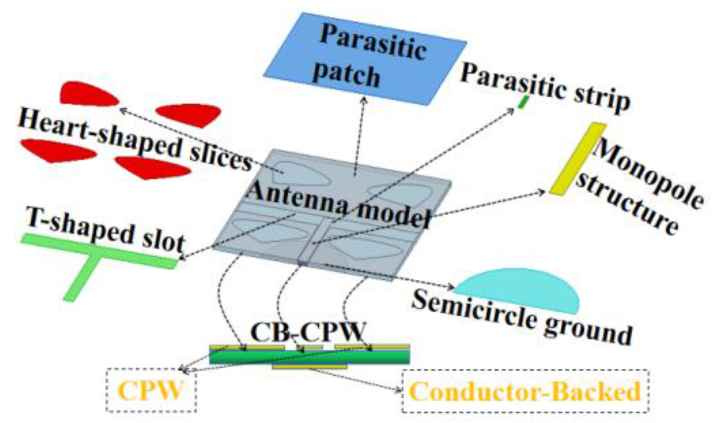

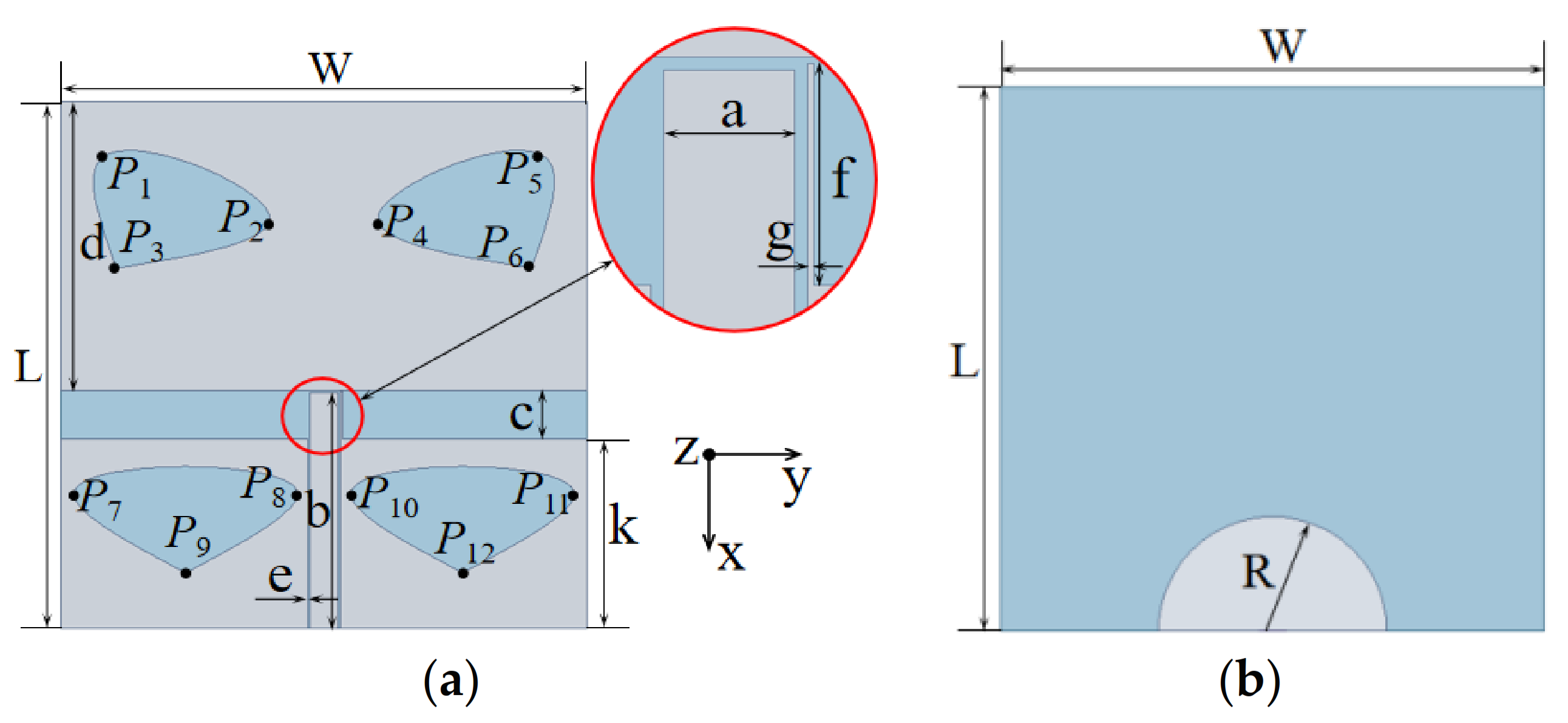
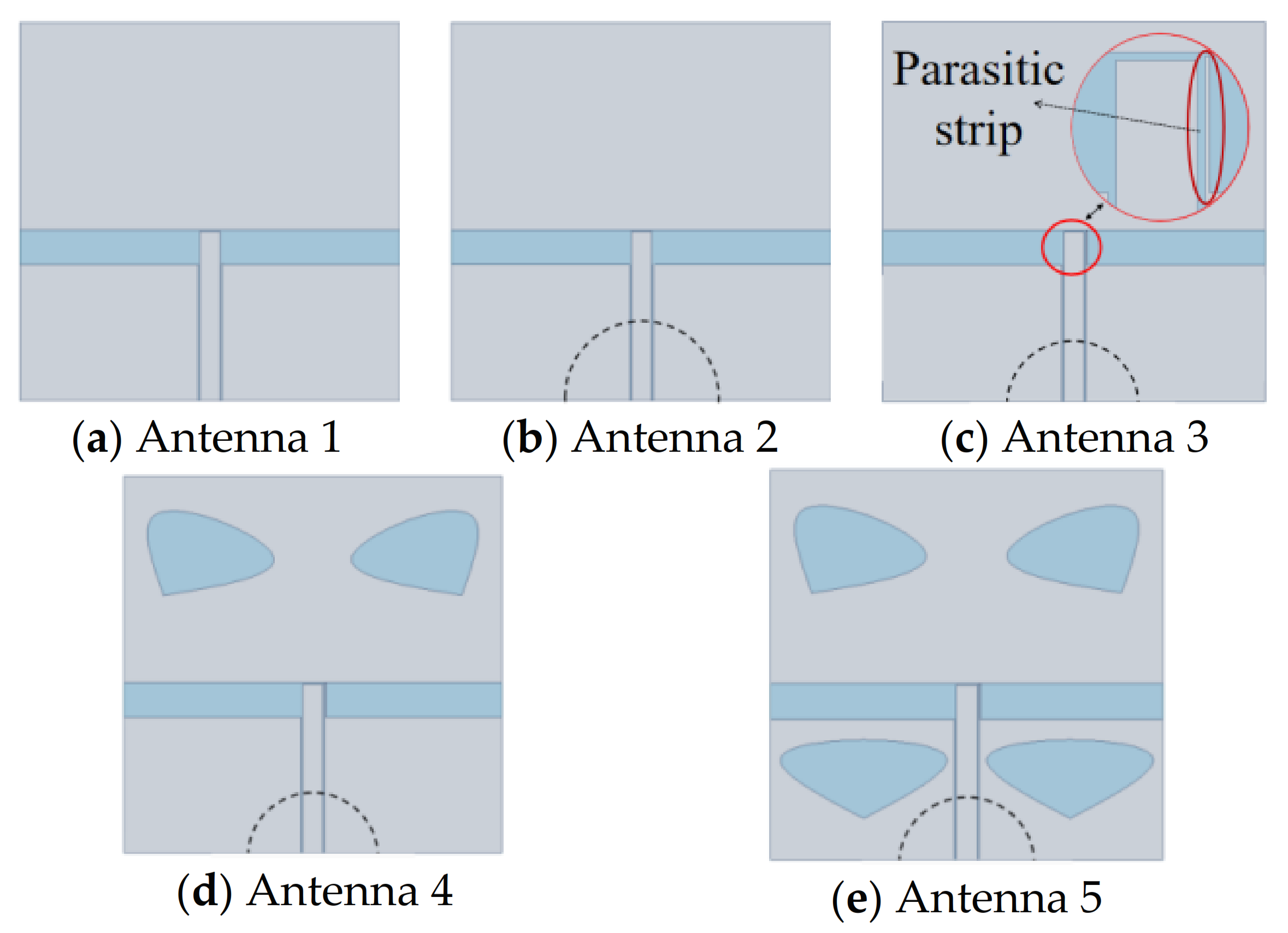

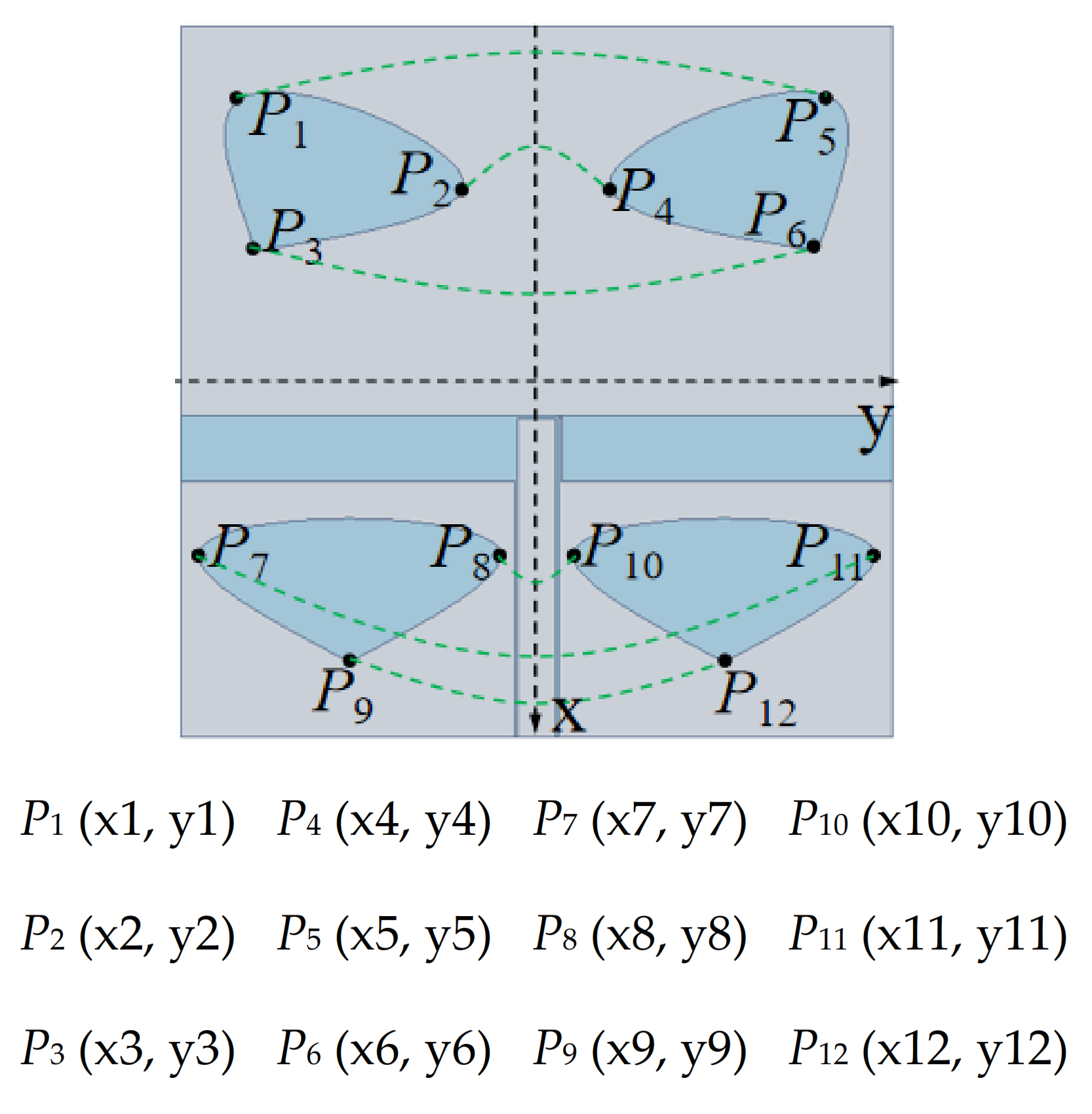
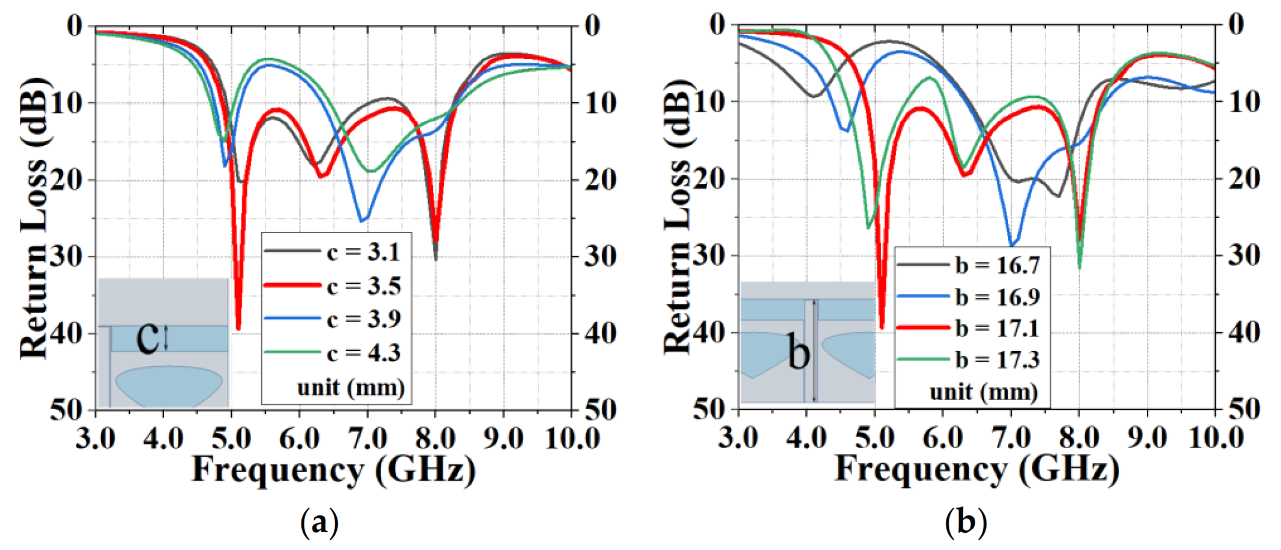
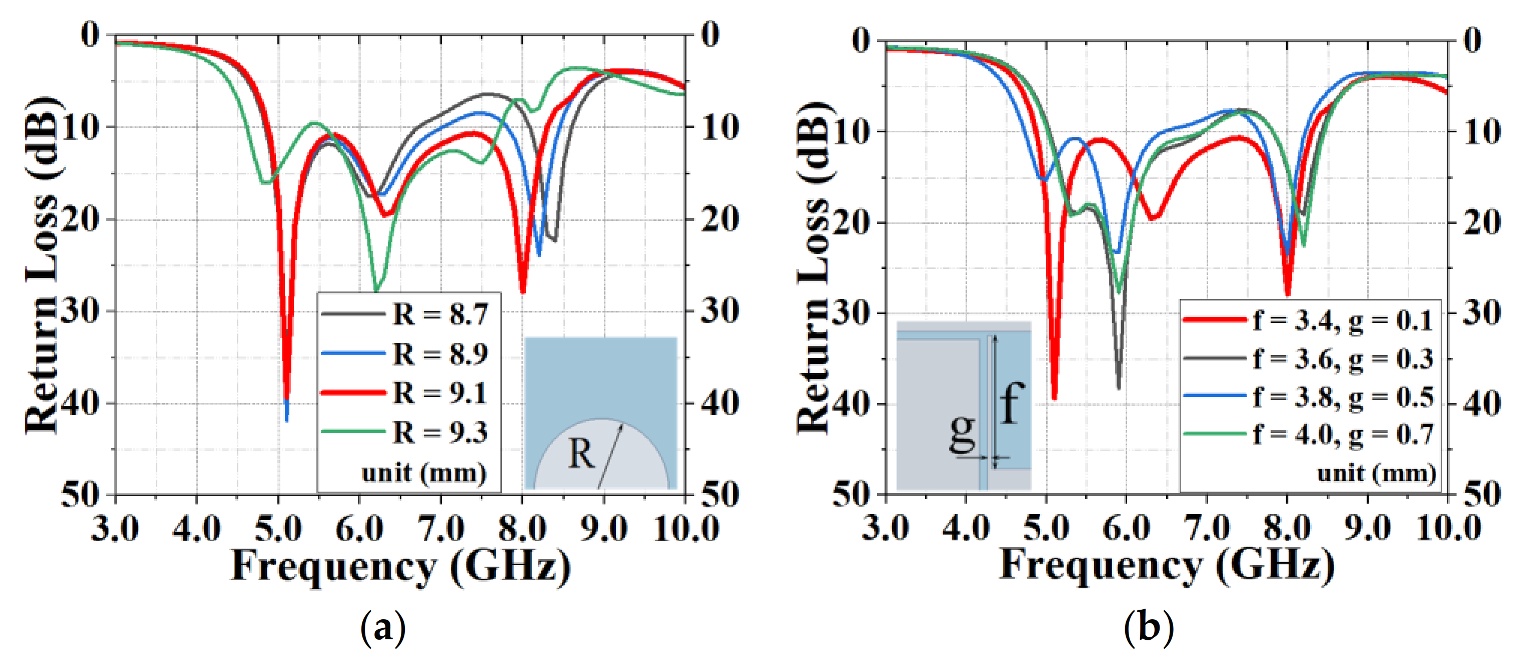
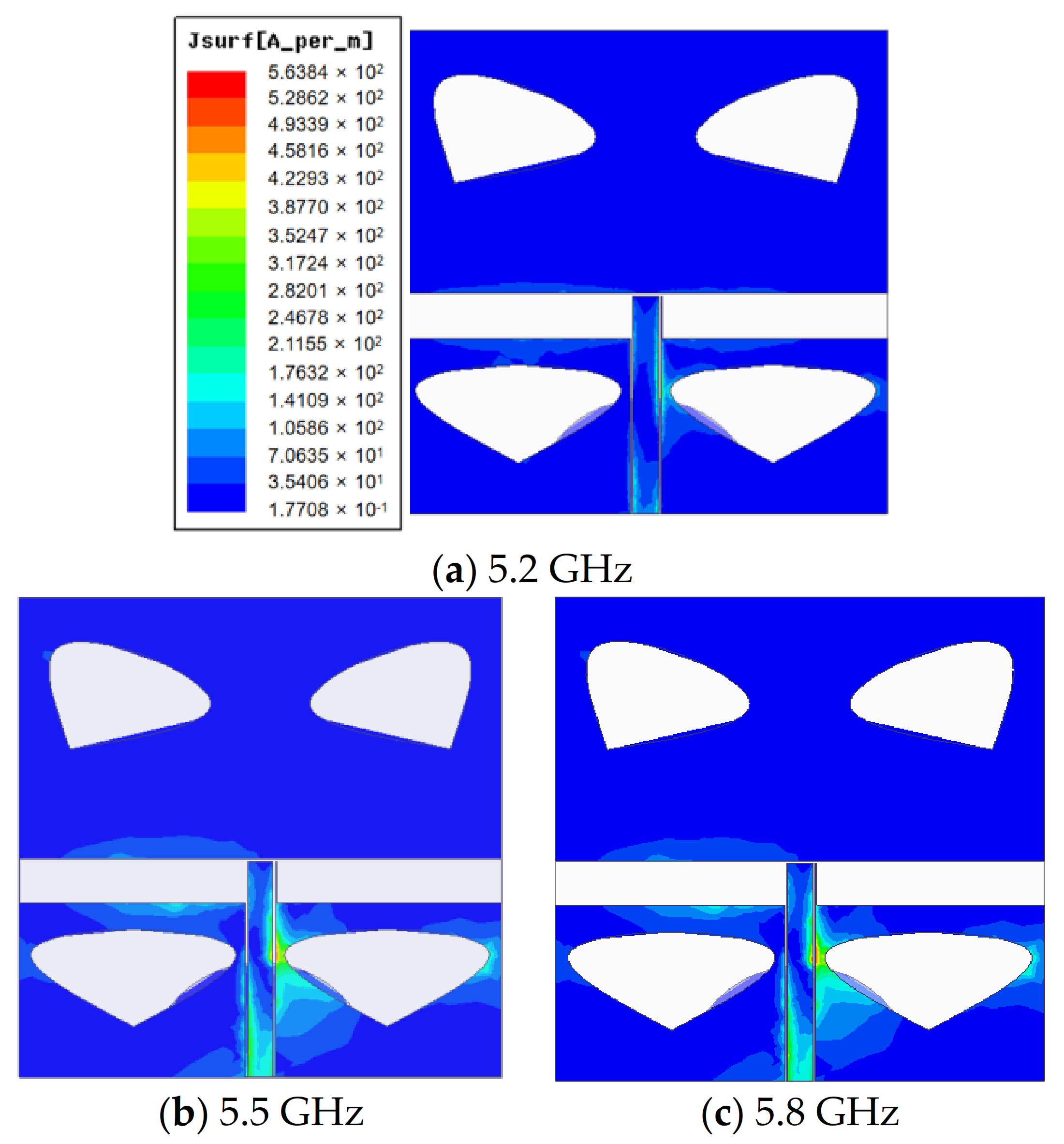
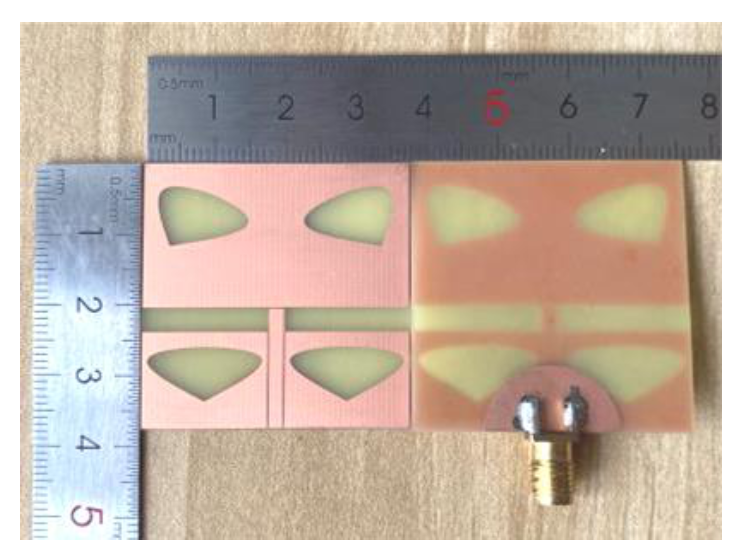

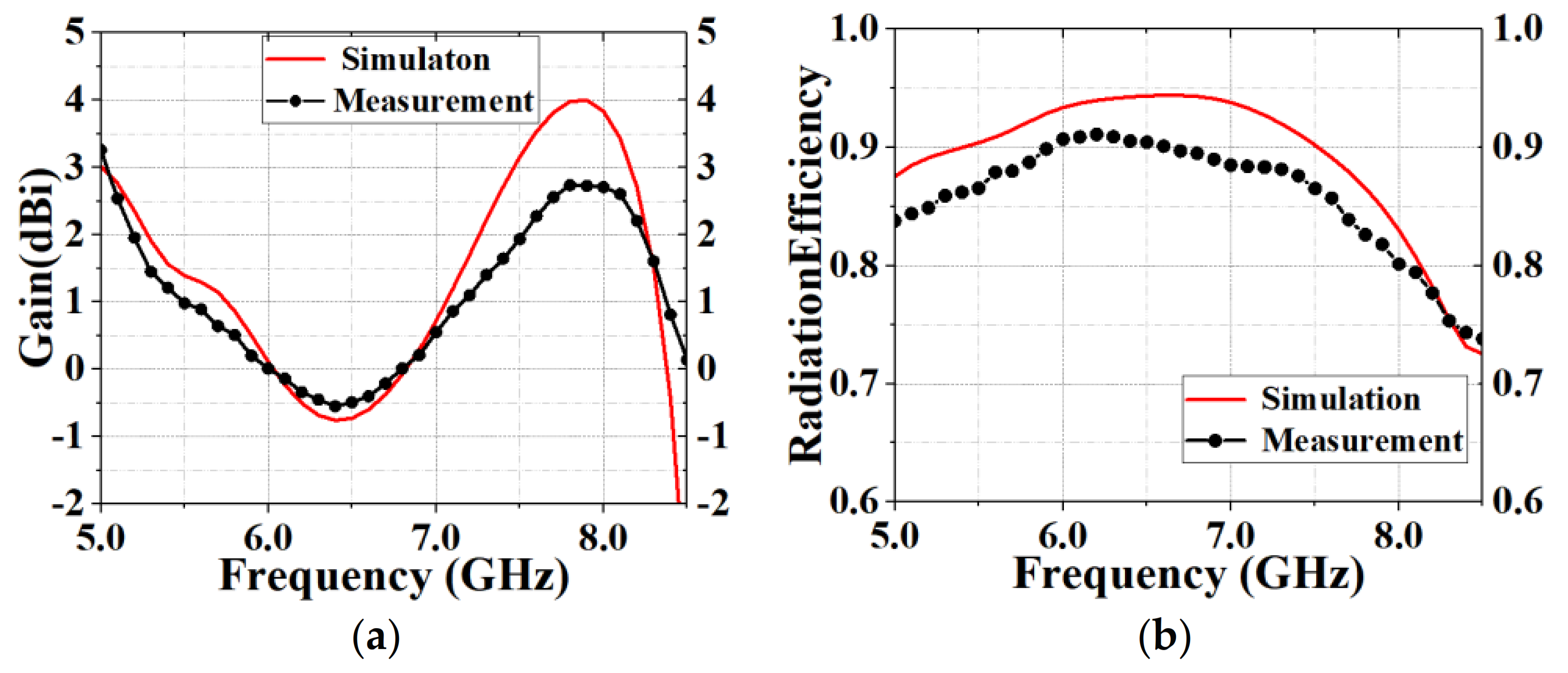
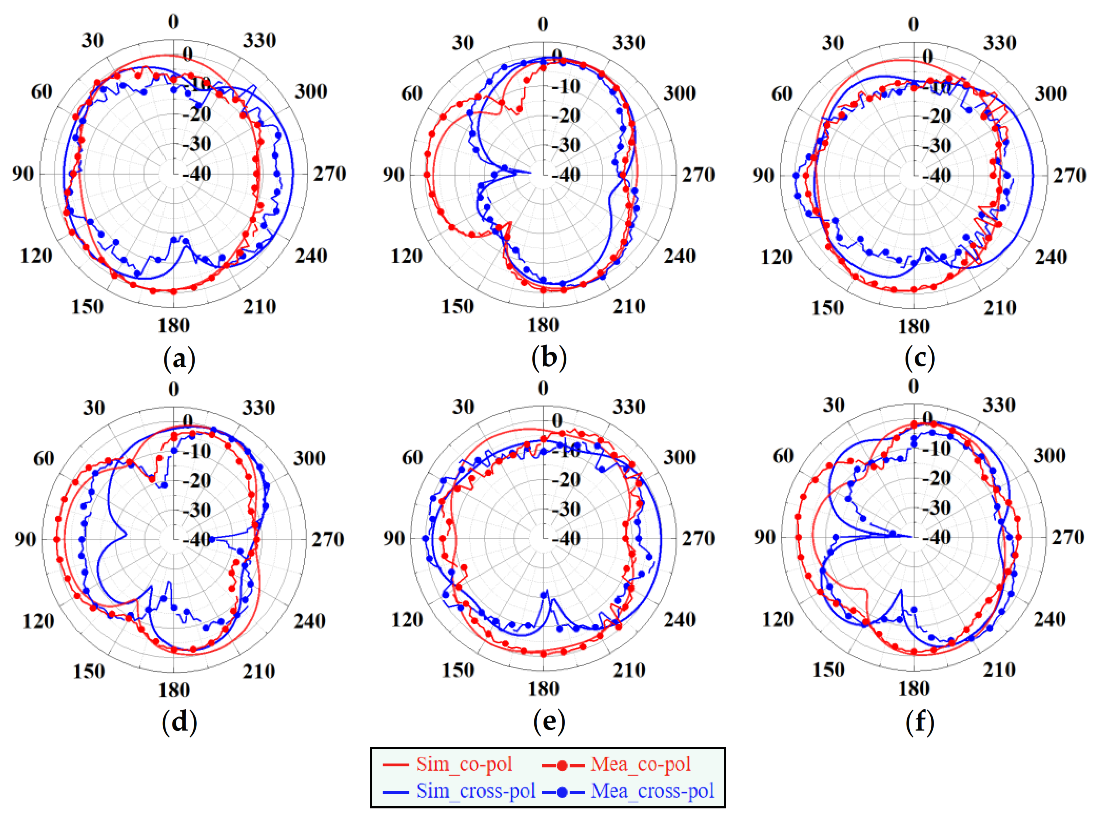
| Ref. | Size (mm3) | Imp. Bandwidth (GHz, %) | Max Gain (dBi) | Max Efficiency (%) |
|---|---|---|---|---|
| [24] | 63 × 75 × 1.6 | 1.81–1.63, 71.63% | 2.5 | 90% |
| [25] | 55 × 50 × 1 | 1.75–4.5, 88% | 2.3 | 95% |
| [26] | 90 × 40 × 0.79 | 2.4–4.2, 54.5% | 3 | / |
| [27] | 60 × 50 × 1.5 | 3.44–6.13, 56.2% | / | 89% |
| [28] | 40 × 40 × 1 | 4.83–8.17, 55% | 3.87 | / |
| [29] | 48 × 43 × 0.8 | 0.115–2.90, 185% | 2.35 | 78.85% |
| [30] | 60 × 40 × 0.8 | 2.3–3.15, 31.2% | 3.7 | / |
| [31] | 70 × 70 × 1.6 | 1.5–2.5, 50% | 5.8 | / |
| [32] | 50 × 50 × 1 | 1.71–3.66, 73.3% | 4 | 80% |
| Proposed | 38 × 38 × 1 | 4.69–8.71, 60% | 3.31 | 91.1% |
Publisher’s Note: MDPI stays neutral with regard to jurisdictional claims in published maps and institutional affiliations. |
© 2020 by the authors. Licensee MDPI, Basel, Switzerland. This article is an open access article distributed under the terms and conditions of the Creative Commons Attribution (CC BY) license (http://creativecommons.org/licenses/by/4.0/).
Share and Cite
Ding, Z.; Wang, H.; Tao, S.; Zhang, D.; Ma, C.; Zhong, Y. A Novel Broadband Monopole Antenna with T-Slot, CB-CPW, Parasitic Stripe and Heart-Shaped Slice for 5G Applications. Sensors 2020, 20, 7002. https://doi.org/10.3390/s20247002
Ding Z, Wang H, Tao S, Zhang D, Ma C, Zhong Y. A Novel Broadband Monopole Antenna with T-Slot, CB-CPW, Parasitic Stripe and Heart-Shaped Slice for 5G Applications. Sensors. 2020; 20(24):7002. https://doi.org/10.3390/s20247002
Chicago/Turabian StyleDing, Zhendong, Hao Wang, Shifei Tao, Dan Zhang, Chunyu Ma, and Yunxian Zhong. 2020. "A Novel Broadband Monopole Antenna with T-Slot, CB-CPW, Parasitic Stripe and Heart-Shaped Slice for 5G Applications" Sensors 20, no. 24: 7002. https://doi.org/10.3390/s20247002
APA StyleDing, Z., Wang, H., Tao, S., Zhang, D., Ma, C., & Zhong, Y. (2020). A Novel Broadband Monopole Antenna with T-Slot, CB-CPW, Parasitic Stripe and Heart-Shaped Slice for 5G Applications. Sensors, 20(24), 7002. https://doi.org/10.3390/s20247002





